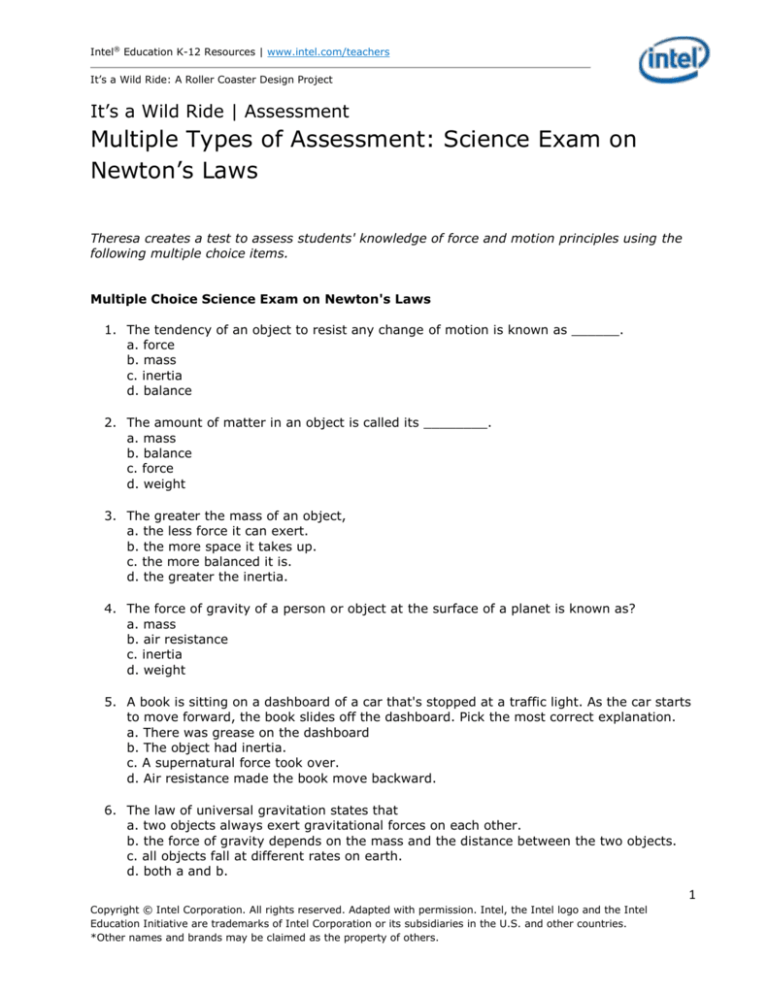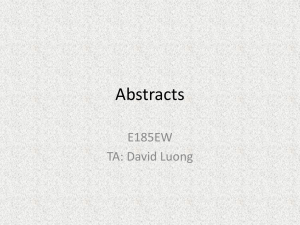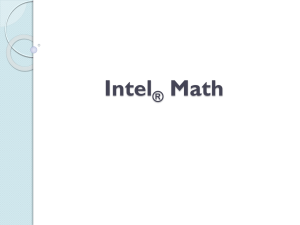
Intel® Education K-12 Resources | www.intel.com/teachers
It’s a Wild Ride: A Roller Coaster Design Project
It’s a Wild Ride | Assessment
Multiple Types of Assessment: Science Exam on
Newton’s Laws
Theresa creates a test to assess students' knowledge of force and motion principles using the
following multiple choice items.
Multiple Choice Science Exam on Newton's Laws
1. The tendency of an object to resist any change of motion is known as ______.
a. force
b. mass
c. inertia
d. balance
2. The amount of matter in an object is called its ________.
a. mass
b. balance
c. force
d. weight
3. The greater the mass of an object,
a. the less force it can exert.
b. the more space it takes up.
c. the more balanced it is.
d. the greater the inertia.
4. The force of gravity of a person or object at the surface of a planet is known as?
a. mass
b. air resistance
c. inertia
d. weight
5. A book is sitting on a dashboard of a car that's stopped at a traffic light. As the car starts
to move forward, the book slides off the dashboard. Pick the most correct explanation.
a. There was grease on the dashboard
b. The object had inertia.
c. A supernatural force took over.
d. Air resistance made the book move backward.
6. The law of universal gravitation states that
a. two objects always exert gravitational forces on each other.
b. the force of gravity depends on the mass and the distance between the two objects.
c. all objects fall at different rates on earth.
d. both a and b.
1
Copyright © Intel Corporation. All rights reserved. Adapted with permission. Intel, the Intel logo and the Intel
Education Initiative are trademarks of Intel Corporation or its subsidiaries in the U.S. and other countries.
*Other names and brands may be claimed as the property of others.
Intel® Education K-12 Resources | www.intel.com/teachers
It’s a Wild Ride: A Roller Coaster Design Project
7. A force that one surface exerts on another when the two rub against each other is called
________.
a. gravity
b. acceleration
c. inertia
d. friction
8. According to Newton's Third Law of Motion, when a hammer strikes and exerts a force on
a nail, the nail
a. creates a balanced force.
b. disappears into the wood.
c. moves at a constant speed.
d. exerts and equal and opposite force back on the hammer.
9. Pick the best example of Newton's Third Law in action.
a. A rocket taking off from earth which pushes gasses in one direction and the rocket in
the other.
b. A rocket sitting on the ground preparing for take-off but it needs an outside force to
overcome its inertia of a non-moving object.
c. A rocket that is accelerating through space and exerts a great amount of force because
its mass and acceleration is so large.
d. Both b and c.
10. Pick the best example of Newton's Second Law in action.
a. A rocket taking off from earth which pushes gasses in one direction and the rocket in
the other.
b. A rocket sitting on the ground preparing for takeoff but it needs an outside force to
overcome its inertia of a nonmoving object.
c. A rocket that is accelerating through space and exerts a great amount of force because
its mass and acceleration is so large.
d. Both b and c.
11. Pick the best example of Newton's First Law in action.
a. A rocket taking off from earth which pushes gasses in one direction and the rocket in
the other.
b. A rocket sitting on the ground preparing for takeoff but it needs an outside force to
overcome its inertia of a nonmoving object.
c. A rocket that is accelerating through space and exerts a great amount of force because
its mass and acceleration is so large.
d. Both b and c
12. According to the law of conservation of momentum, when two objects collide in the
absence of friction,
a. momentum is not lost.
b. velocity increases.
c. velocity decreases.
d. only the object with the larger mass continues on.
13. Which of the following is an example of momentum in action?
a. A person jogging through the park.
2
Copyright © Intel Corporation. All rights reserved. Adapted with permission. Intel, the Intel logo and the Intel
Education Initiative are trademarks of Intel Corporation or its subsidiaries in the U.S. and other countries.
*Other names and brands may be claimed as the property of others.
Intel® Education K-12 Resources | www.intel.com/teachers
It’s a Wild Ride: A Roller Coaster Design Project
b. A bowling ball hitting pins.
c. A person playing pool.
d. Both b and c.
14. How can you increase the momentum of an object?
a. By increasing its mass or velocity.
b. By increasing its acceleration and friction force.
c. By increasing its friction force and mass.
d. Both b and c.
15. An example of a balanced force is
a. a car sliding on ice.
b. a tug-of-war game in which no one wins.
c. a car hitting a telephone pole.
d. a roller coaster going down the first drop.
16. An example of an unbalanced force (net force) is
a. a car parked in the garage.
b. a tug-of-war game in which no one wins.
c. a bridge.
d. a roller coaster going down the first drop.
17. In physical science, a push or pull is called a(n)________.
a. gravity
b. force
c. universal law
d. inertia
18. When two equal forces act on the same object in opposite directions, the net force is
________.
a. crazy
b. greater than either force
c. zero
d. smaller than either force
19. The word "acceleration" means to
a. exert a force on another object.
b. create a balanced force on another object.
c. create an unbalanced force on another object.
d. change the speed or direction.
20. Which is the best example of a constant speed?
a. A car cruising on the Interstate.
b. A car cruising on CIM Street.
c. A car crashing into another car.
d. A car exploding.
21. What is the difference between an average speed and a constant speed?
a. A constant speed has the same speed at every point on a graph, and average speed is
computed by dividing the total distance by the total time; each point on the graph could
3
Copyright © Intel Corporation. All rights reserved. Adapted with permission. Intel, the Intel logo and the Intel
Education Initiative are trademarks of Intel Corporation or its subsidiaries in the U.S. and other countries.
*Other names and brands may be claimed as the property of others.
Intel® Education K-12 Resources | www.intel.com/teachers
It’s a Wild Ride: A Roller Coaster Design Project
be a different speed.
b. Constant speed is faster than average speed.
c. Average speed is faster than constant speed.
d. An average speed has the same speed at every point on a graph, and a constant
speed is computed by dividing the total distance by the total time; each point on the
graph could be a different speed.
22. Two main outside forces acting on most anything on earth are
a. friction and mass.
b. friction and gravity.
c. gravity and inertia.
d. gravity and mass.
23. A roller coaster climbing the first hill is an example of
a. building kinetic energy.
b. building potential energy.
c. gravitational forces.
d. nuclear energy.
24. A roller coaster going down the first drop is an example of
a. kinetic energy.
b. potential energy.
c. nuclear energy.
d. all of the above.
25. The force that pulls falling objects to Earth is called
a. free fall.
b. gravity.
c. air resistance.
d. acceleration.
If the item describes kinetic energy, write KE. If the item describes potential
energy, write PE.
26. A person running __________
27. A new car battery __________
28. The top of a roller coaster __________
29. A flag blowing in the wind __________
Use the diagram below to answer questions 30-32.
4
Copyright © Intel Corporation. All rights reserved. Adapted with permission. Intel, the Intel logo and the Intel
Education Initiative are trademarks of Intel Corporation or its subsidiaries in the U.S. and other countries.
*Other names and brands may be claimed as the property of others.
Intel® Education K-12 Resources | www.intel.com/teachers
It’s a Wild Ride: A Roller Coaster Design Project
30. A car of a roller coaster coasts from point A to point B. The speed of the car increases
because.
a. only balanced forces act on the car.
b. an inside force acts on the car.
c. only unbalanced forces act on the car.
d. no forces act on the car.
31. The car is able to travel between points B and C even though it is uphill because of
______.
a. gravity
b. friction
c. inertia
d. both b and c
32. The force that opposes motion between the car's wheels and the track of the roller
coaster is ______.
a. net
b. balanced
c. friction
d. inertia
Use the diagram below to answer questions 33-37 by circling the letter that best
answers each question.
33. What is the average speed of the cyclist?
a. 10 km/min.
b. 10 km/hour
c. 70 km/hour
d. 1 hour/km
34. What is the average speed of the roller coaster?
a. 20 m/sec.
b. 120 m/sec.
c. 2.4 m/sec.
d. 60 m/sec.
35. During which interval is the roller coaster's speed the greatest?
a. Between 4 sec. and 5 sec.
b. Between 3 sec. and 4 sec.
5
Copyright © Intel Corporation. All rights reserved. Adapted with permission. Intel, the Intel logo and the Intel
Education Initiative are trademarks of Intel Corporation or its subsidiaries in the U.S. and other countries.
*Other names and brands may be claimed as the property of others.
Intel® Education K-12 Resources | www.intel.com/teachers
It’s a Wild Ride: A Roller Coaster Design Project
c. Between 2 sec. and 3 sec.
d. Between 1 sec. and 2 sec.
36. How might you explain the interval between the 2nd and 3rd second on the roller coaster
graph?
a. The roller coaster reached a constant speed.
b. The roller coaster is at the bottom of a loop.
c. The roller coaster is at the top of a camelback.
d. The emergency brakes were applied forcing the car to a stop.
37. Which graph shows a constant speed?
a. The roller coaster graph
b. The cyclist graph
38. A sprinter runs the 225m in a time of 25 seconds. What is the sprinter's speed?
a. 5625 m/sec.
b. 56 m/sec.
c. 9 m/sec.
d. 9 m/hr
39. A 535 kg car is moving at a velocity of 55 m/hr north. What is the car's momentum?
a. 29.42 kg-cm/hr
b. 9.72 kg-m/hr
c. 29,425 kg-m/hr
d. 972 kg-m/hr
Answer the questions below after reading the following passage.
A massive roller coaster has been built in Twin Falls, ID and you have been hired to make
some calculations for their promotional brochure. The company has heard about your
expertise in this area. The roller coaster has a height of 285 meters on the first hill. The drop
length is 310 meters (on the first hill). It takes 3 seconds for the roller coaster car to go
from the top to the bottom of the first drop. It takes 4 seconds to reach the top of the
second hill, which is 150 meters in length. You have realized there is a flaw in the design
because the force on the second hill is too great. You notify the builders and become a local
hero celebrated for your intelligence. (Oh, by the way, the mass of the roller coasters cars is
225 kg). Draw a diagram, it will help. Attach your work process.
40. What was the force on the second hill?
a. -3234.36 N
b. 0.0733 N
c. -3,703 N
41. What is the speed on the first drop?
a. 95 m/sec.
b. 103.33 m/sec.
c. 323.22 m/sec.
6
Copyright © Intel Corporation. All rights reserved. Adapted with permission. Intel, the Intel logo and the Intel
Education Initiative are trademarks of Intel Corporation or its subsidiaries in the U.S. and other countries.
*Other names and brands may be claimed as the property of others.
Intel® Education K-12 Resources | www.intel.com/teachers
It’s a Wild Ride: A Roller Coaster Design Project
42. What is the momentum after the first drop?
a. 23,249.25 kg-m/sec.
b. 2,137 g-m/sec.
c. 21,375 kg-m/sec.
d. 57.8 kg-m/sec.
43. What is the kinetic energy of the first drop?
a. 1,201 N
b. 1,015,312.50 kg-m2/s2
c. 1,201,172 kg-m2/s2
44. What is the potential energy of the first drop?
a. 628.42 N
b. 64,125 J
c. 683,550 J
d. 628,425 J
45. Which of Newton's Laws would allow a passenger to fly right out of his seat if he did not
have a lap belt over him and the roller coaster suddenly stopped?
a. First law - "Once in motion..."
b. Second law - "Mass x acceleration =..."
c. Third law - "For every action there is an..."
46. Your body bouncing back into your seat after hitting the lap bar is an example of which of
Newton's Laws in action?
a. First law - "Once in motion..."
b. Second law - "Mass x acceleration =..."
c. Third law - "For every action there is an..."
47. The amount of force of the passenger as he hits the lap bar is an example of which of
Newton's Laws in action?
a. First law - "Once in motion..."
b. Second law - "Mass x acceleration =..."
c. Third law - "For every action there is an..."
Label the following numbers (Answers may be used more than once)
a. Acceleration
b. Speed
c. Force
d. Momentum
e. Kinetic Energy
f. G.P.E.
48. __________
49. __________
50. __________
51. __________
52. __________
53. __________
54. __________
2.56 m/sec.
143.2 cm/sec/hour
2.7 km/sec.2
52 kg-m/sec.
632.6 kg-m2/s2
748,987 J
786 N.
7
Copyright © Intel Corporation. All rights reserved. Adapted with permission. Intel, the Intel logo and the Intel
Education Initiative are trademarks of Intel Corporation or its subsidiaries in the U.S. and other countries.
*Other names and brands may be claimed as the property of others.
Intel® Education K-12 Resources | www.intel.com/teachers
It’s a Wild Ride: A Roller Coaster Design Project
55. __________ 85 mi./hr.
56. Convert 55.7 g into kilograms
a. .557 kg
b. .00557 kg
c. .0557 kg
d. 55700 kg
57. Convert 678.92 cm into meters
a. 6.7892 m
b. 67892 m
c. .67892 m
d. 678920 m
58. Convert 25 m into centimeters
a. 250 cm
b. 2,500 cm
c. .25 cm
d. .025 cm
59. Convert 25 m into kilometers
a. 2500 km
b. .25 km
c. .025 km
d. 25000 km
60. Convert 43.89 km into meters
a. .04389 m
b. .4389 m
c. 43,890 m
d. .004389 m
61. When energy is stored it is called ________.
a. kinetic energy
b. potential energy
c. nuclear energy
d. gravitational energy
62. What is energy called when it is released?
a. Kinetic energy
b. Potential energy
c. Nuclear energy
d. Gravitational energy
63. How much would an object weigh on the moon if its mass is 656 kg and the moon's
gravitational rate is 1.6 m/sec/sec?
a. 6,618.8 N
b. 1,049.6 J
c. 1,049.6 N
d. 6,618.8 J
8
Copyright © Intel Corporation. All rights reserved. Adapted with permission. Intel, the Intel logo and the Intel
Education Initiative are trademarks of Intel Corporation or its subsidiaries in the U.S. and other countries.
*Other names and brands may be claimed as the property of others.
Intel® Education K-12 Resources | www.intel.com/teachers
It’s a Wild Ride: A Roller Coaster Design Project
64. How much would the same object weight on earth?
a. 6428.8 N
b. 1049.6 J
c. 1049.6 N
d. 6428.8 J
65. What is the speed of a free-falling object on the 3rd second?
a. 19.6 m/sec/sec
b. 29.4 m/sec/sec
c. 39.2 m/sec/sec
d. None of the above.
66. What is the definition of weight?
a. A gravitational force on a mass.
b. How big an object is.
c. The amount of matter in an object.
d. The amount of space an object takes up.
9
Copyright © Intel Corporation. All rights reserved. Adapted with permission. Intel, the Intel logo and the Intel
Education Initiative are trademarks of Intel Corporation or its subsidiaries in the U.S. and other countries.
*Other names and brands may be claimed as the property of others.





